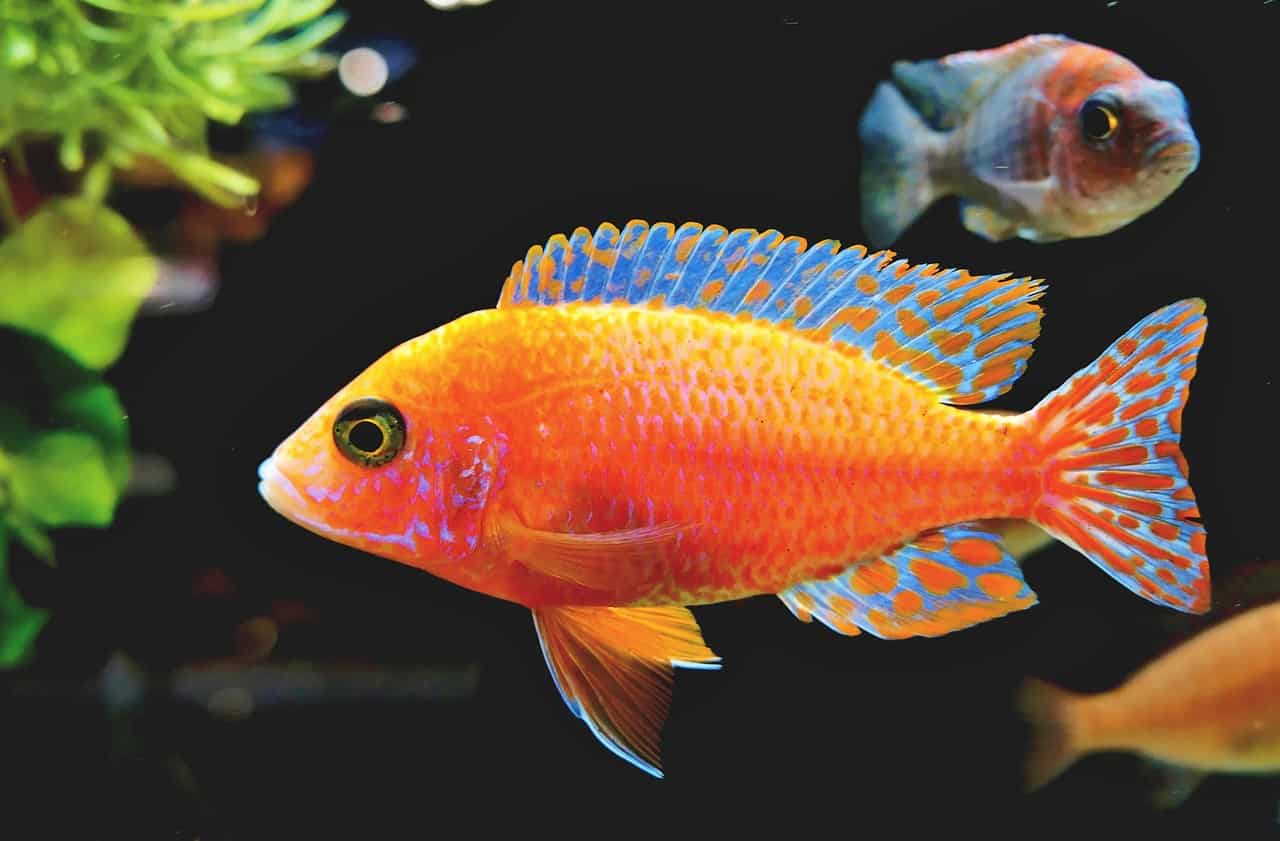Can wrasses get along?
Here’s some ways to keep several Fairy Wrasses, several Flasher Wrasses, or a mixture of both!
Perusing the Internet, I have noticed more and more aquarists questioning, not only the compatibility of fairy wrasses Cirrhilabrus species, but also the compatibility of flasher wrasses Paracheilinus species.
Questions can vary from, “Can you put several fairy wrasses in the same tank?” or “Can you put several flasher wrasses in the same tank?” to “Would adding females make for more aggression?” and “Can you put flasher and fairy wrasses together?”
Some aquarists, such as myself, have had 4 or 5 fairy wrasses together, usually without a problem in a 150-gallon tank, yet others have had disastrous results. Why the variation? Is it tank size or length that matters? There are so many variables, thus aquarists need to include all other fish tank mates (not the inverts or corals), tank volume, and tank length when stating success or failure. This will help to narrow down what is, or what is not successful.
So many variables demand specifics. My hopes are to present some techniques that I have used successfully, along with future experiments involving compatibility. One thing I did notice is when you have a more peaceful community; certain fish behave better, yet when adding rambunctious fish, the bad attitude or skittishness seems to spread to the other fish. That is a topic for another blog! Now on to my first wrasse experiment and my past experiences. Note that all these fish are male.
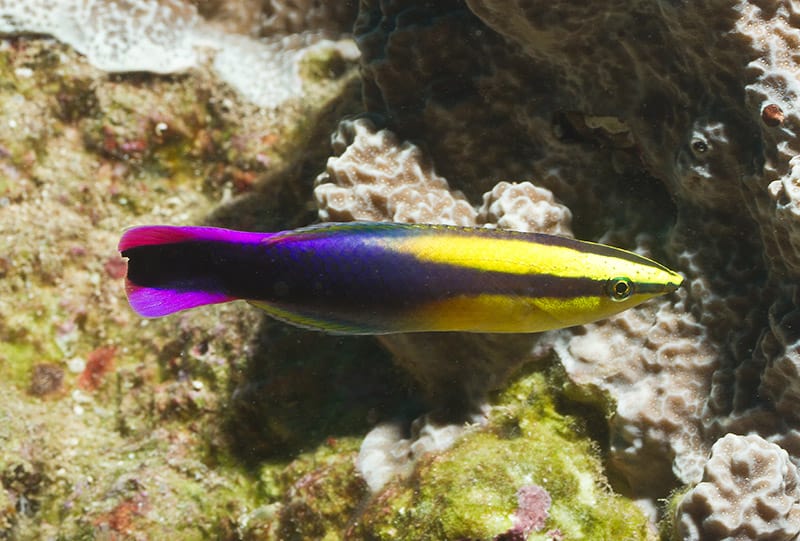
Filamented Flasher Wrasse and Solar Fairy Wrasse
I first want to discuss my current tank set up and how the Filamented Flasher Wrasse Paracheilinus filamentosus and the Solar Fairy Wrasse Cirrhilabrus solorensis are getting along. My tank is 75 gallons, 4′ long and contains a Flame Angelfish, male and female Picasso and Platinum Percula Clownfish, Royal Gramma, Lawnmower Blenny, established 5″ Yellowhead (neon) Wrasse Halichoeres garnoti, and a cleaner wrasse. It is embarrassing to admit I have a cleaner wrasse, yet after 6 weeks he is still alive and eating mysis, however, longevity is never promising with these wrasses.
When I got home late on a Wednesday, the lights in the tank were out, and knowing that the 3″ young Flame Angelfish would NOT be happy with any new tank mates I would be adding, I took precautions. While the little darling was sleeping, I rearranged the rockwork while I acclimated the two wrasses.
Once I finished the tank remodel, the wrasses were ready to enter their new home and I’m still waiting on the security deposit they BOTH promised me! Typical of these two genuses of wrasses, they need crevices or caves to spin their cocoon in, as they sleep. I had two separate caves for them, and holding each wrasse securely in my hand, one by one, I gently introduced them into their own cave. It was awesome how quickly each accepted their hide out and both quickly spun a cocoon and stayed in for the night!
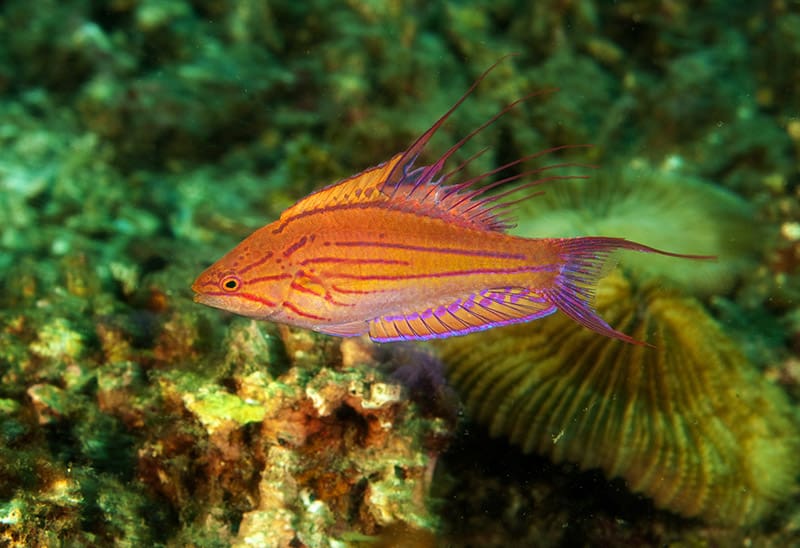
The next morning, the Flame Angelfish was quite curious and took a few runs at the wrasses, but nothing serious. I must point out that BOTH the Filamented Flasher Wrasse and the Solar Fairy Wrasse were the same size, around 2.5″ from nose to the base of the tailfin. This means the flasher wrasse is probably in its “late teens” since the Filamented Flashers only reach 3.9.” The Solar Fairy wrasse is probably in its early teens and will reach a maximum of about 5″ at adulthood.
The first few days, the Solar Fairy charged the Filamented Flasher very aggressively, but only in short bursts, with no apparent contact or bite marks. This continued for the first week, however, it was not a constant occurrence. By the middle of the second week, they hardly pay attention to each other. The Filamented Flasher Wrasse prefers to hang out near the two clownfish in the front right corner of the tank, and the Solar Fairy Wrasse is all over the place, typical of these wrasses. The Flame Angelfish seems to keep the Solar Fairy occupied and periodically darts at him, leaving no damage. The only time the two wrasses interact is when the flasher wrasse gets spook and darts in the direction of the Solar Fairy, who then reacts as any normal creature would if someone is running at them!
I have observed that the Flame Angelfish occupies the Solar Fairy Wrasse’s attention by periodically chasing him, so that may be a variable as to why both wrasses are working out. Has anyone else had these two wrasses WITHOUT a dwarf angelfish with success?

What’s Next?
My next attempt will be to add a Lubbocki’s Fairy Wrasse or another flasher wrasse like a McCosker’s Flasher or Carpenter Flasher Wrasse. In a previous tank I had a Rosey Scale Fairy Wrasse Cirrhilabrus rubrisquamis who was a constant companion to my Solar Fairy Wrasse, so I may even try adding 3 next time. When this happens, I will add all 3 at the same time, to divide the attention of the established Filamented Flasher and Solar Fairy. I will again rearrange the rockwork to break up territories that the Flame Angelfish will have and to distract the little red monster! I was told I should try female flasher wrasses, yet I feel this may compromise the harmony of the males.
Two Previous Fairy Wrasse Communities
As I mentioned earlier, I had a 150-gallon tank with 2 different sets of fairy wrasses Cirrhilabrus species at different times. The first set of fairy wrasses were added in the following order: Solar Fairy Wrasse Cirrhilabrus Solorensis, Lubbocki Fairy Wrasse C. Lubbocki, Scott’s Fairy Wrasse C. Scottorum, Velvet Fairy Wrasse C. luteovittatus, and then a Whipfin Fairy Wrasse C. filamentous.
The Solar Fairy and the Lubbocki were settled in for several months before I added the Scott’s Fairy Wrasse and the Velvet Fairy Wrasse. When I added the Scott’s Fairy and the Velvet Fairy, the Solar Fairy then hid under a rock, but fortunately he was visible so I could keep an eye on him. His color was blotchy and he was obviously very intimidated by his two new tank mates. The Solar Fairy would grab food as it floated by, so I was not worried about him eating, although at the two-week mark, I needed to make a decision to remove him. At the 10-day mark he started to come out and the other wrasses passively checked him out, but there was no aggression. I think he realized they were not a threat and all this hiding was just silly! Who knows the mind of a fairy wrasse! Maybe it’s along the lines of, “Food, food, and food, OH! there’s a copepod! NOM NOM NOM… food, food, food… OH! There’s my human! Okay, look cute and fluttery and fairyish!” Did I feed them this morning?
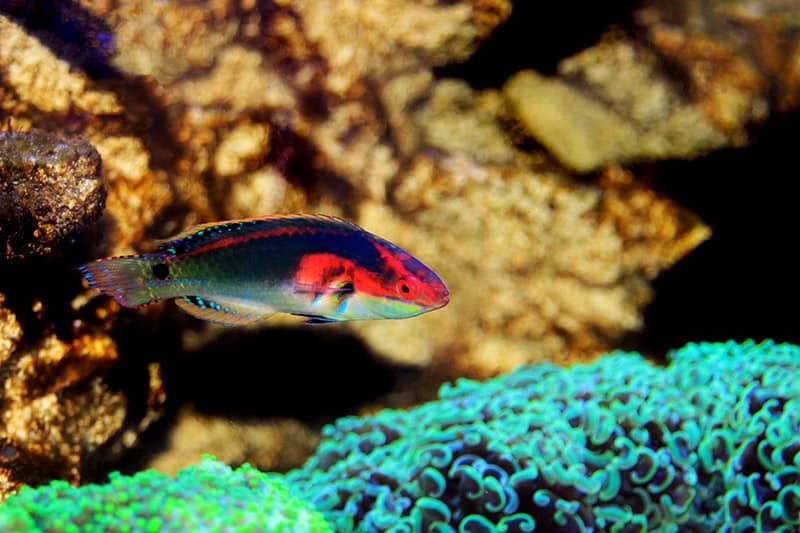
The mistake I made was adding the Whipfin Fairy Wrasse last. This fish was so freaked out; it enlisted in a carpet surfing competition! After watching carefully, I saw that the Velvet Fairy Wrasse was the pursuer and antagonizer, who also chased my Lubbocki up and out of the tank to join the Whipfin’s team! I did get rid of the Velvet Fairy Wrasse after the Lubbocki jumped ship, however there were no bite marks or wounds, so I assumed he just ran out of water depth trying to get away from the Yellow-Streaked demon Velvet Fairy!
Interestingly, I did have a Harlequin Tuskfish who never paid the other wrasses any attention. The Solar Fairy Wrasse had no problem with the smaller and more peaceful fairy wrasses yet could hold its own with the larger fairy wrasses. I am guessing he was not much of a threat, but his size kept them at bay. I call the Solar Fairy Wrasse the “crossover” wrasse and this is why I chose it to put it with a flasher wrasse in the above experiment.
The second set of wrasses came after a tank crash, which occurred while I was away for 2 weeks. At any rate, I had decided to add several wrasses at one time. They consisted of a small Red Scaled Wrasse Cirrhilabrus rubisquamis, a larger Temminck’s Fairy Wrasse C. temminckii and a Lubbocki Fairy Wrasse. I already had another Solar Fairy Wrasse in the tank of course! The only issue was that the Lubbocki Fairy Wrasse did jump out of the tank, so I decided not to add any more of the smaller, more peaceful wrasses with the more aggressive larger wrasses.
The Temmincki Fairy Wrasse was spectacular and in charge. This fish would swim at the upper level of the tank, with characteristics of a flasher wrasse, with an electric appearance to the lines on his body! As he swam near the surface, I always worried about him jumping out, yet he never did. I didn’t have any aggressive fish in the tank, so that may have been the reason for my success!
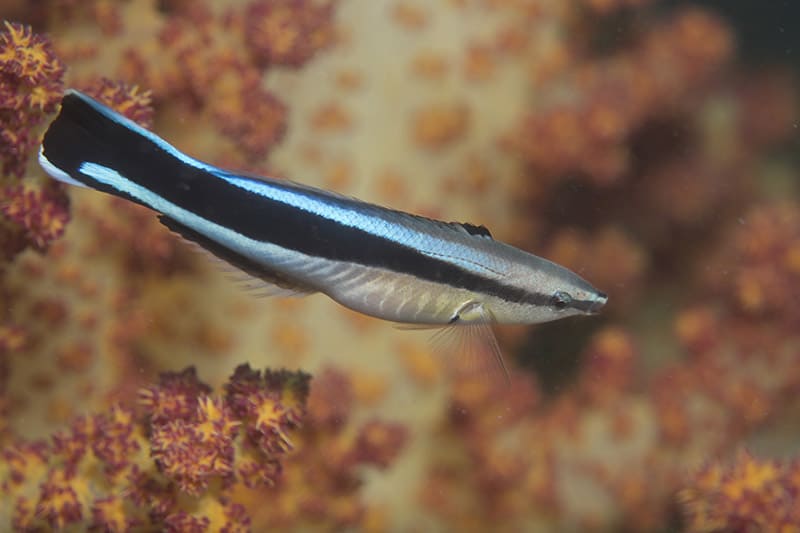
What to Try
In conclusion, try adding smaller and more peaceful wrasses first and if possible add them all at the same time. If you cannot do that, add two or three at a time and rearrange the rockwork to diffuse aggression. Several choices would be; to stay only with the smaller and more peaceful wrasses, go with the larger and more aggressive fairy wrasses (possibly not involving flasher wrasses in this group, unless it is an aggressive species if such a fish exists), or have a dense population of wrasses to diffuse aggression between the larger and smaller wrasses, while providing many places to hide and plenty of food to eat.
Lessening aggression with food, distraction, and hiding places is an almost universal solution when it comes to many fish. For those who are having problems with their wrasses, try the elliptical or stair master! Or for your fish, try rearranging the rockwork. Yes I know that is hard, but your body and your fish will thank you for it! Catching a wrasse can prove difficult in some cases, so give that a shot first! Interestingly, this method of rock work rearrangement works great when introducing a new Tang/Surgeonfish to a tank with establish Tangs/Surgeonfish. If that does not work, remove your largest or smallest wrasse, since either the tank size or length, or aggression may be the issue. PLEASE let us know of any success or observations, and include other fish, tank size, and tank length in your comment.
Carrie McBirney is a team member at Animal-World and has contributed many articles and write-ups.
Featured Image Credit: Ralphs_Fotos, Pixabay
